Resource Economics: Principles of Resource Allocation, Environmental Resources, and Government Action
VerifiedAdded on 2023/06/13
|7
|1745
|313
AI Summary
This article discusses the principles of resource allocation, environmental resources such as groundwater supplies, biodiversity protection, and coal mining, and government action in conserving resources. It also covers the scarcity of non-renewable resources, physical and economic measures, and the role of recycling in managing the problem of scarcity. Economic factors to evaluate recycling are also discussed.
Contribute Materials
Your contribution can guide someone’s learning journey. Share your
documents today.
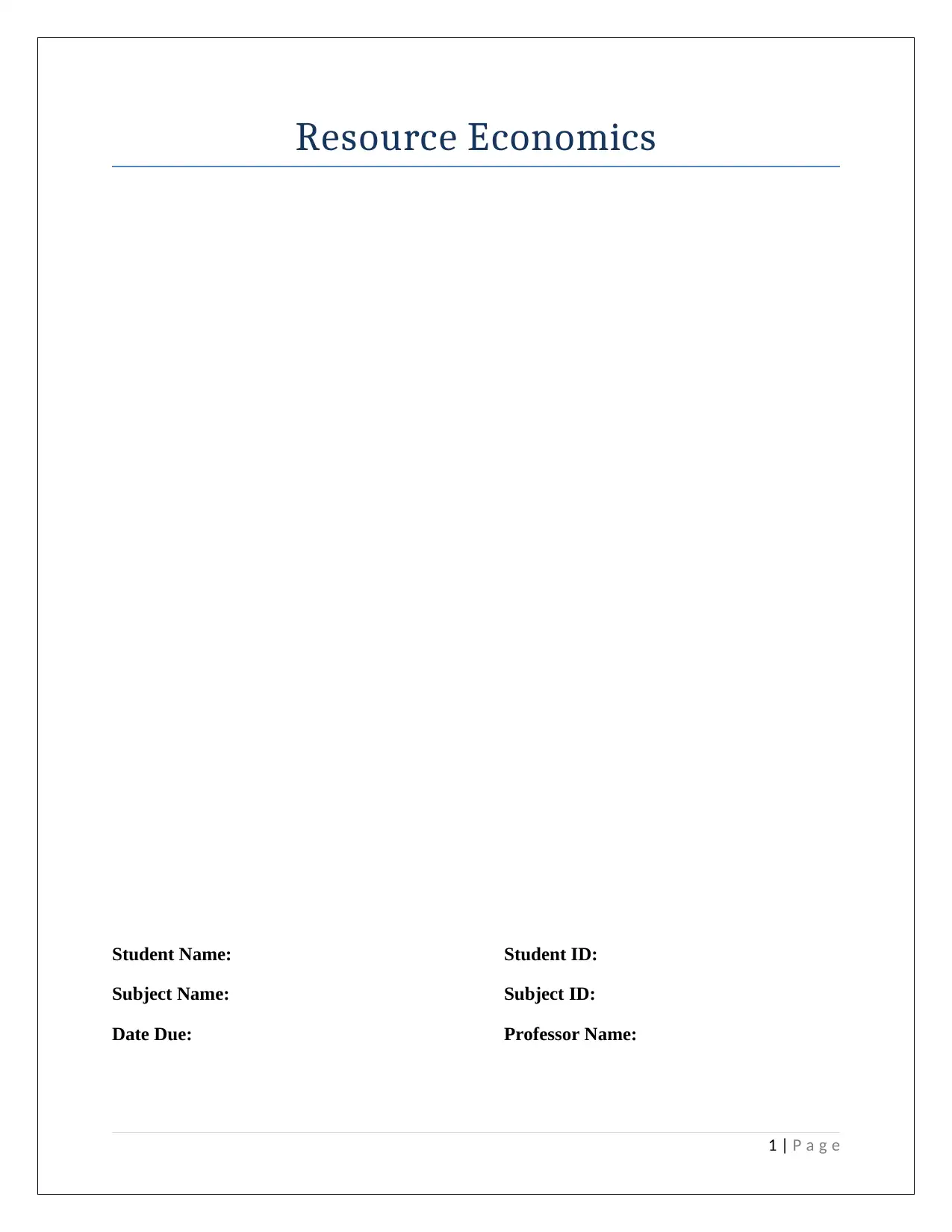
Resource Economics
Student Name: Student ID:
Subject Name: Subject ID:
Date Due: Professor Name:
1 | P a g e
Student Name: Student ID:
Subject Name: Subject ID:
Date Due: Professor Name:
1 | P a g e
Secure Best Marks with AI Grader
Need help grading? Try our AI Grader for instant feedback on your assignments.
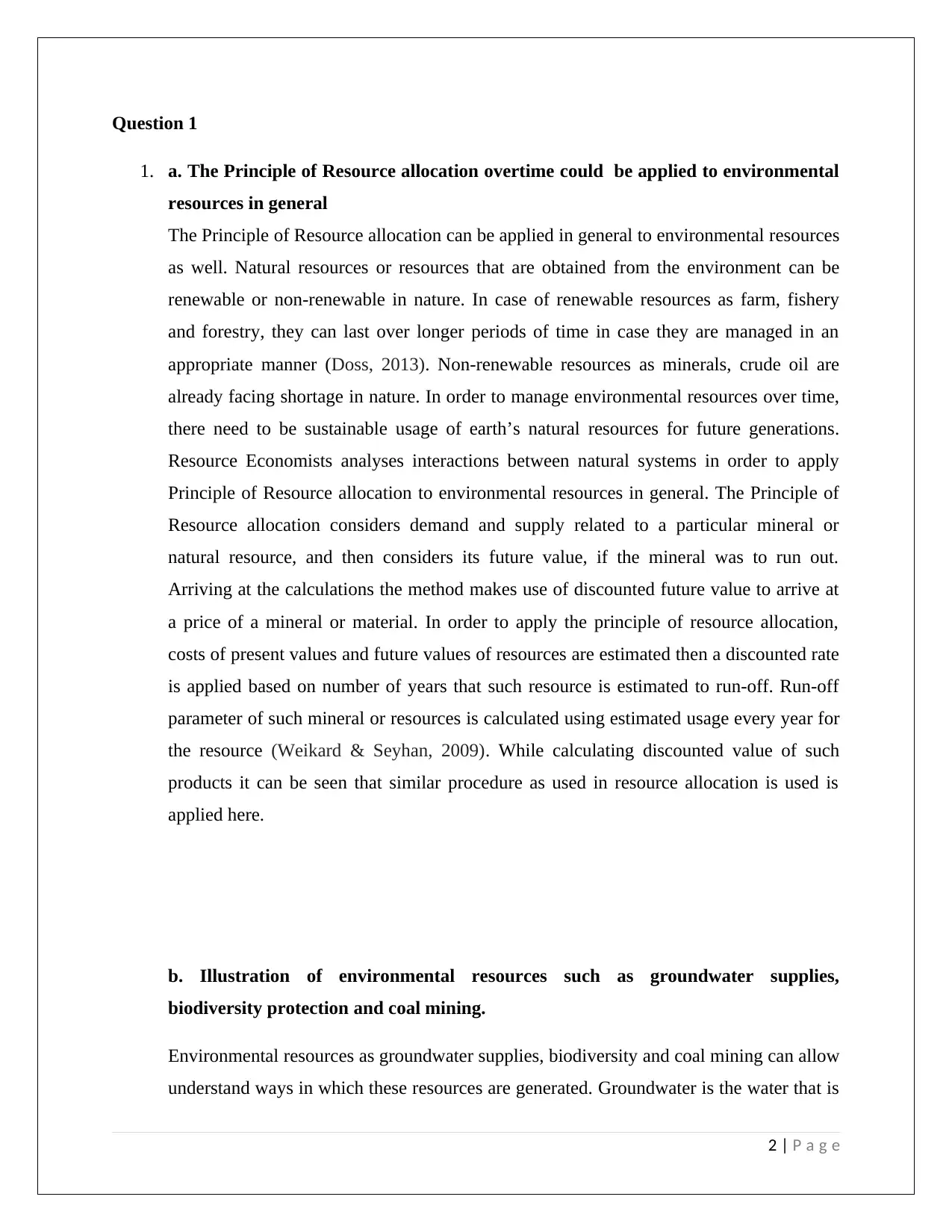
Question 1
1. a. The Principle of Resource allocation overtime could be applied to environmental
resources in general
The Principle of Resource allocation can be applied in general to environmental resources
as well. Natural resources or resources that are obtained from the environment can be
renewable or non-renewable in nature. In case of renewable resources as farm, fishery
and forestry, they can last over longer periods of time in case they are managed in an
appropriate manner (Doss, 2013). Non-renewable resources as minerals, crude oil are
already facing shortage in nature. In order to manage environmental resources over time,
there need to be sustainable usage of earth’s natural resources for future generations.
Resource Economists analyses interactions between natural systems in order to apply
Principle of Resource allocation to environmental resources in general. The Principle of
Resource allocation considers demand and supply related to a particular mineral or
natural resource, and then considers its future value, if the mineral was to run out.
Arriving at the calculations the method makes use of discounted future value to arrive at
a price of a mineral or material. In order to apply the principle of resource allocation,
costs of present values and future values of resources are estimated then a discounted rate
is applied based on number of years that such resource is estimated to run-off. Run-off
parameter of such mineral or resources is calculated using estimated usage every year for
the resource (Weikard & Seyhan, 2009). While calculating discounted value of such
products it can be seen that similar procedure as used in resource allocation is used is
applied here.
b. Illustration of environmental resources such as groundwater supplies,
biodiversity protection and coal mining.
Environmental resources as groundwater supplies, biodiversity and coal mining can allow
understand ways in which these resources are generated. Groundwater is the water that is
2 | P a g e
1. a. The Principle of Resource allocation overtime could be applied to environmental
resources in general
The Principle of Resource allocation can be applied in general to environmental resources
as well. Natural resources or resources that are obtained from the environment can be
renewable or non-renewable in nature. In case of renewable resources as farm, fishery
and forestry, they can last over longer periods of time in case they are managed in an
appropriate manner (Doss, 2013). Non-renewable resources as minerals, crude oil are
already facing shortage in nature. In order to manage environmental resources over time,
there need to be sustainable usage of earth’s natural resources for future generations.
Resource Economists analyses interactions between natural systems in order to apply
Principle of Resource allocation to environmental resources in general. The Principle of
Resource allocation considers demand and supply related to a particular mineral or
natural resource, and then considers its future value, if the mineral was to run out.
Arriving at the calculations the method makes use of discounted future value to arrive at
a price of a mineral or material. In order to apply the principle of resource allocation,
costs of present values and future values of resources are estimated then a discounted rate
is applied based on number of years that such resource is estimated to run-off. Run-off
parameter of such mineral or resources is calculated using estimated usage every year for
the resource (Weikard & Seyhan, 2009). While calculating discounted value of such
products it can be seen that similar procedure as used in resource allocation is used is
applied here.
b. Illustration of environmental resources such as groundwater supplies,
biodiversity protection and coal mining.
Environmental resources as groundwater supplies, biodiversity and coal mining can allow
understand ways in which these resources are generated. Groundwater is the water that is
2 | P a g e
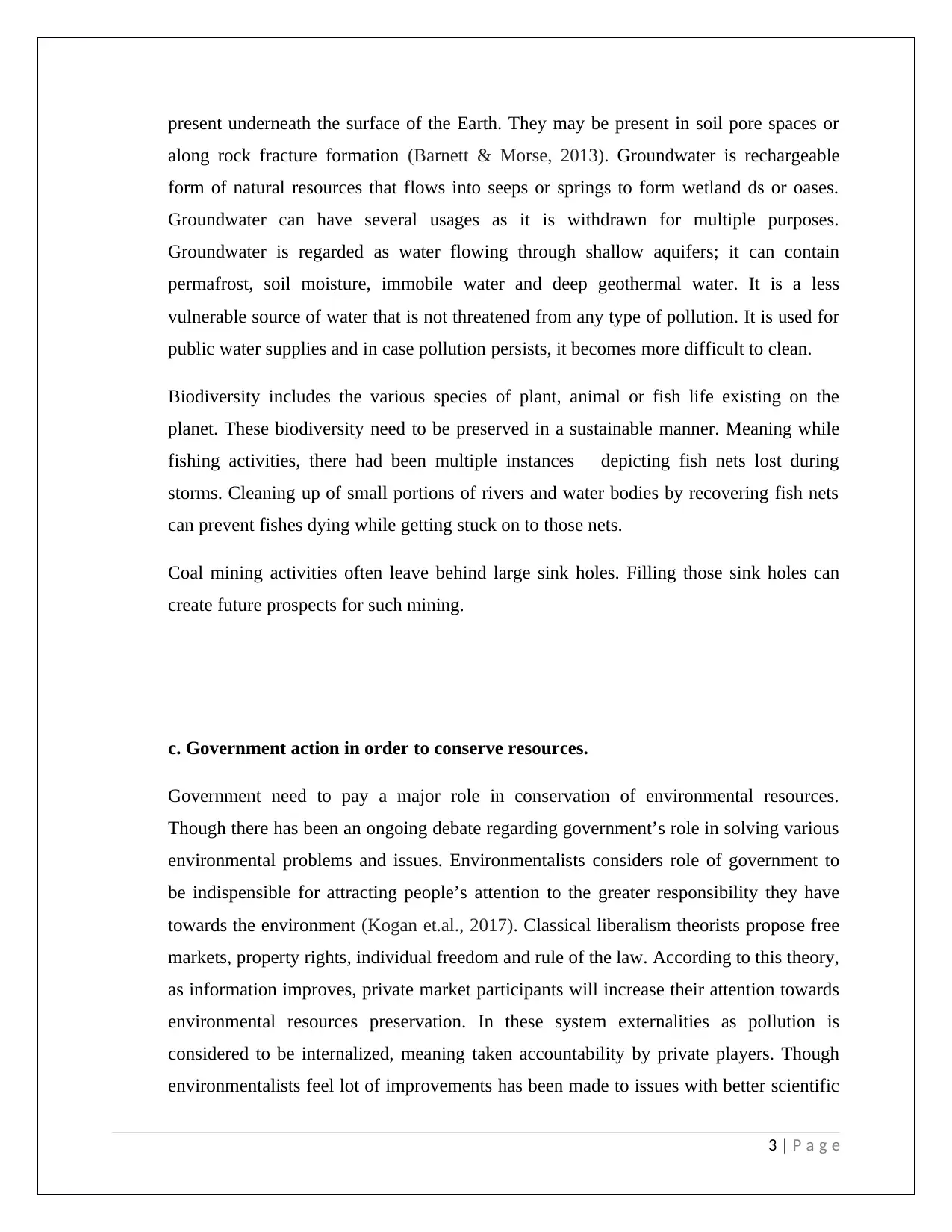
present underneath the surface of the Earth. They may be present in soil pore spaces or
along rock fracture formation (Barnett & Morse, 2013). Groundwater is rechargeable
form of natural resources that flows into seeps or springs to form wetland ds or oases.
Groundwater can have several usages as it is withdrawn for multiple purposes.
Groundwater is regarded as water flowing through shallow aquifers; it can contain
permafrost, soil moisture, immobile water and deep geothermal water. It is a less
vulnerable source of water that is not threatened from any type of pollution. It is used for
public water supplies and in case pollution persists, it becomes more difficult to clean.
Biodiversity includes the various species of plant, animal or fish life existing on the
planet. These biodiversity need to be preserved in a sustainable manner. Meaning while
fishing activities, there had been multiple instances depicting fish nets lost during
storms. Cleaning up of small portions of rivers and water bodies by recovering fish nets
can prevent fishes dying while getting stuck on to those nets.
Coal mining activities often leave behind large sink holes. Filling those sink holes can
create future prospects for such mining.
c. Government action in order to conserve resources.
Government need to pay a major role in conservation of environmental resources.
Though there has been an ongoing debate regarding government’s role in solving various
environmental problems and issues. Environmentalists considers role of government to
be indispensible for attracting people’s attention to the greater responsibility they have
towards the environment (Kogan et.al., 2017). Classical liberalism theorists propose free
markets, property rights, individual freedom and rule of the law. According to this theory,
as information improves, private market participants will increase their attention towards
environmental resources preservation. In these system externalities as pollution is
considered to be internalized, meaning taken accountability by private players. Though
environmentalists feel lot of improvements has been made to issues with better scientific
3 | P a g e
along rock fracture formation (Barnett & Morse, 2013). Groundwater is rechargeable
form of natural resources that flows into seeps or springs to form wetland ds or oases.
Groundwater can have several usages as it is withdrawn for multiple purposes.
Groundwater is regarded as water flowing through shallow aquifers; it can contain
permafrost, soil moisture, immobile water and deep geothermal water. It is a less
vulnerable source of water that is not threatened from any type of pollution. It is used for
public water supplies and in case pollution persists, it becomes more difficult to clean.
Biodiversity includes the various species of plant, animal or fish life existing on the
planet. These biodiversity need to be preserved in a sustainable manner. Meaning while
fishing activities, there had been multiple instances depicting fish nets lost during
storms. Cleaning up of small portions of rivers and water bodies by recovering fish nets
can prevent fishes dying while getting stuck on to those nets.
Coal mining activities often leave behind large sink holes. Filling those sink holes can
create future prospects for such mining.
c. Government action in order to conserve resources.
Government need to pay a major role in conservation of environmental resources.
Though there has been an ongoing debate regarding government’s role in solving various
environmental problems and issues. Environmentalists considers role of government to
be indispensible for attracting people’s attention to the greater responsibility they have
towards the environment (Kogan et.al., 2017). Classical liberalism theorists propose free
markets, property rights, individual freedom and rule of the law. According to this theory,
as information improves, private market participants will increase their attention towards
environmental resources preservation. In these system externalities as pollution is
considered to be internalized, meaning taken accountability by private players. Though
environmentalists feel lot of improvements has been made to issues with better scientific
3 | P a g e
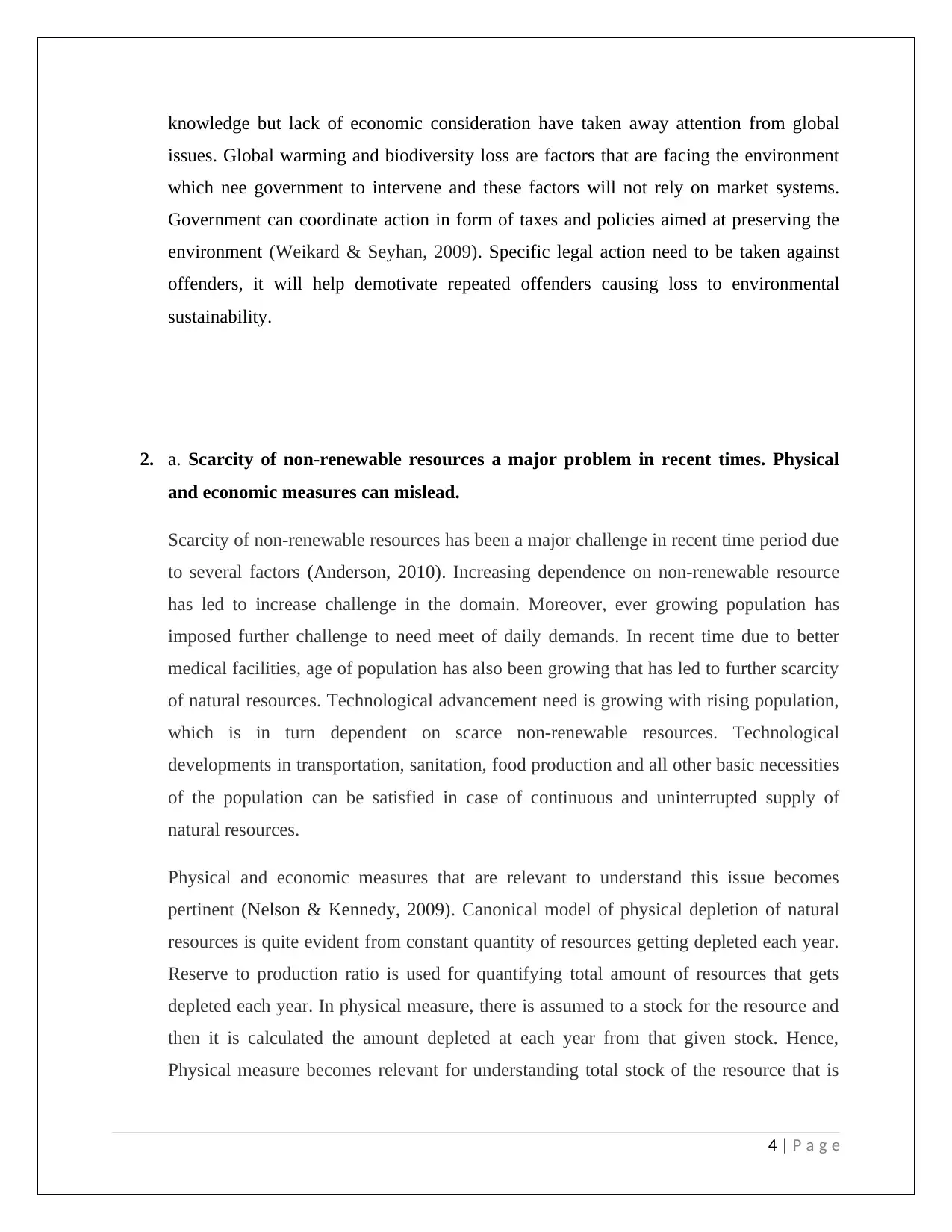
knowledge but lack of economic consideration have taken away attention from global
issues. Global warming and biodiversity loss are factors that are facing the environment
which nee government to intervene and these factors will not rely on market systems.
Government can coordinate action in form of taxes and policies aimed at preserving the
environment (Weikard & Seyhan, 2009). Specific legal action need to be taken against
offenders, it will help demotivate repeated offenders causing loss to environmental
sustainability.
2. a. Scarcity of non-renewable resources a major problem in recent times. Physical
and economic measures can mislead.
Scarcity of non-renewable resources has been a major challenge in recent time period due
to several factors (Anderson, 2010). Increasing dependence on non-renewable resource
has led to increase challenge in the domain. Moreover, ever growing population has
imposed further challenge to need meet of daily demands. In recent time due to better
medical facilities, age of population has also been growing that has led to further scarcity
of natural resources. Technological advancement need is growing with rising population,
which is in turn dependent on scarce non-renewable resources. Technological
developments in transportation, sanitation, food production and all other basic necessities
of the population can be satisfied in case of continuous and uninterrupted supply of
natural resources.
Physical and economic measures that are relevant to understand this issue becomes
pertinent (Nelson & Kennedy, 2009). Canonical model of physical depletion of natural
resources is quite evident from constant quantity of resources getting depleted each year.
Reserve to production ratio is used for quantifying total amount of resources that gets
depleted each year. In physical measure, there is assumed to a stock for the resource and
then it is calculated the amount depleted at each year from that given stock. Hence,
Physical measure becomes relevant for understanding total stock of the resource that is
4 | P a g e
issues. Global warming and biodiversity loss are factors that are facing the environment
which nee government to intervene and these factors will not rely on market systems.
Government can coordinate action in form of taxes and policies aimed at preserving the
environment (Weikard & Seyhan, 2009). Specific legal action need to be taken against
offenders, it will help demotivate repeated offenders causing loss to environmental
sustainability.
2. a. Scarcity of non-renewable resources a major problem in recent times. Physical
and economic measures can mislead.
Scarcity of non-renewable resources has been a major challenge in recent time period due
to several factors (Anderson, 2010). Increasing dependence on non-renewable resource
has led to increase challenge in the domain. Moreover, ever growing population has
imposed further challenge to need meet of daily demands. In recent time due to better
medical facilities, age of population has also been growing that has led to further scarcity
of natural resources. Technological advancement need is growing with rising population,
which is in turn dependent on scarce non-renewable resources. Technological
developments in transportation, sanitation, food production and all other basic necessities
of the population can be satisfied in case of continuous and uninterrupted supply of
natural resources.
Physical and economic measures that are relevant to understand this issue becomes
pertinent (Nelson & Kennedy, 2009). Canonical model of physical depletion of natural
resources is quite evident from constant quantity of resources getting depleted each year.
Reserve to production ratio is used for quantifying total amount of resources that gets
depleted each year. In physical measure, there is assumed to a stock for the resource and
then it is calculated the amount depleted at each year from that given stock. Hence,
Physical measure becomes relevant for understanding total stock of the resource that is
4 | P a g e
Secure Best Marks with AI Grader
Need help grading? Try our AI Grader for instant feedback on your assignments.
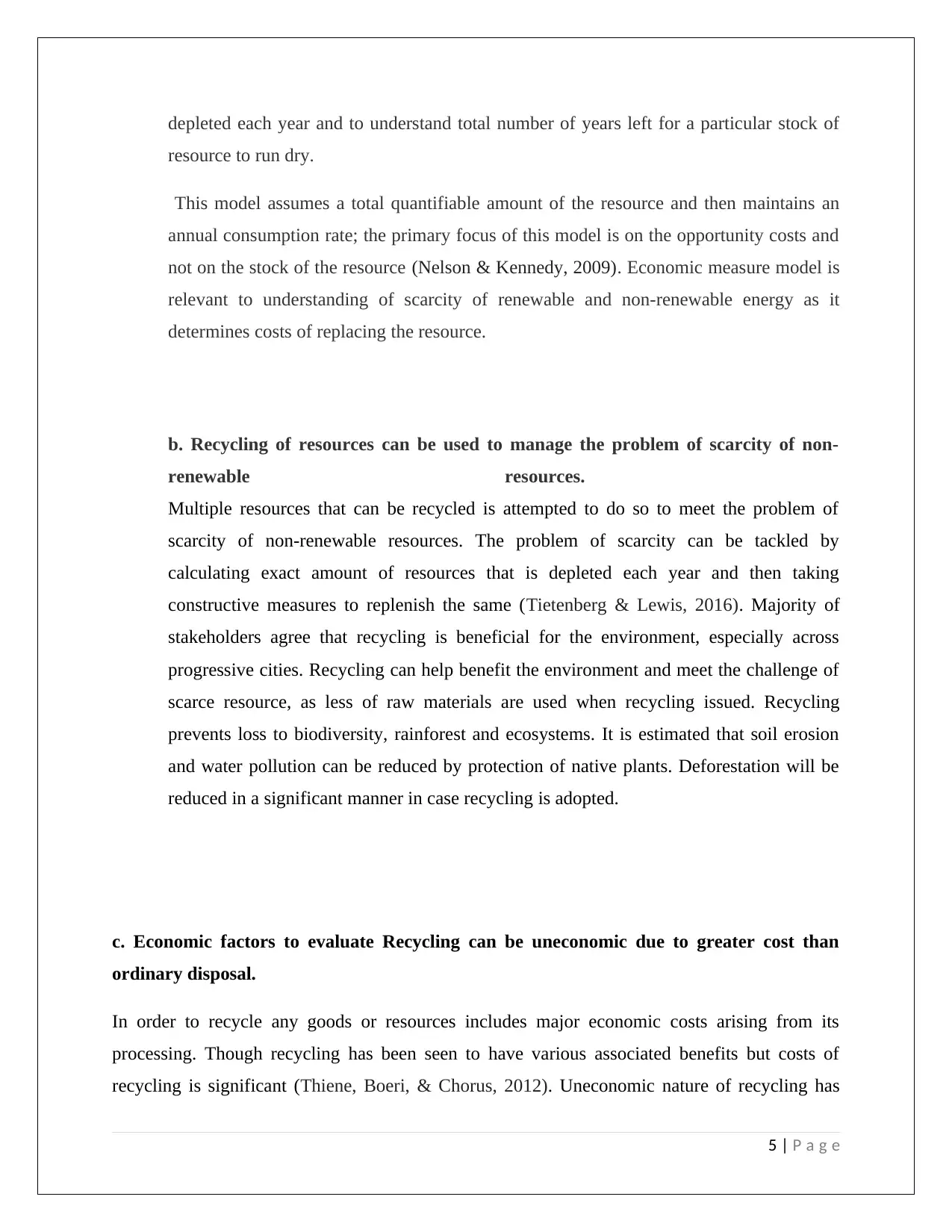
depleted each year and to understand total number of years left for a particular stock of
resource to run dry.
This model assumes a total quantifiable amount of the resource and then maintains an
annual consumption rate; the primary focus of this model is on the opportunity costs and
not on the stock of the resource (Nelson & Kennedy, 2009). Economic measure model is
relevant to understanding of scarcity of renewable and non-renewable energy as it
determines costs of replacing the resource.
b. Recycling of resources can be used to manage the problem of scarcity of non-
renewable resources.
Multiple resources that can be recycled is attempted to do so to meet the problem of
scarcity of non-renewable resources. The problem of scarcity can be tackled by
calculating exact amount of resources that is depleted each year and then taking
constructive measures to replenish the same (Tietenberg & Lewis, 2016). Majority of
stakeholders agree that recycling is beneficial for the environment, especially across
progressive cities. Recycling can help benefit the environment and meet the challenge of
scarce resource, as less of raw materials are used when recycling issued. Recycling
prevents loss to biodiversity, rainforest and ecosystems. It is estimated that soil erosion
and water pollution can be reduced by protection of native plants. Deforestation will be
reduced in a significant manner in case recycling is adopted.
c. Economic factors to evaluate Recycling can be uneconomic due to greater cost than
ordinary disposal.
In order to recycle any goods or resources includes major economic costs arising from its
processing. Though recycling has been seen to have various associated benefits but costs of
recycling is significant (Thiene, Boeri, & Chorus, 2012). Uneconomic nature of recycling has
5 | P a g e
resource to run dry.
This model assumes a total quantifiable amount of the resource and then maintains an
annual consumption rate; the primary focus of this model is on the opportunity costs and
not on the stock of the resource (Nelson & Kennedy, 2009). Economic measure model is
relevant to understanding of scarcity of renewable and non-renewable energy as it
determines costs of replacing the resource.
b. Recycling of resources can be used to manage the problem of scarcity of non-
renewable resources.
Multiple resources that can be recycled is attempted to do so to meet the problem of
scarcity of non-renewable resources. The problem of scarcity can be tackled by
calculating exact amount of resources that is depleted each year and then taking
constructive measures to replenish the same (Tietenberg & Lewis, 2016). Majority of
stakeholders agree that recycling is beneficial for the environment, especially across
progressive cities. Recycling can help benefit the environment and meet the challenge of
scarce resource, as less of raw materials are used when recycling issued. Recycling
prevents loss to biodiversity, rainforest and ecosystems. It is estimated that soil erosion
and water pollution can be reduced by protection of native plants. Deforestation will be
reduced in a significant manner in case recycling is adopted.
c. Economic factors to evaluate Recycling can be uneconomic due to greater cost than
ordinary disposal.
In order to recycle any goods or resources includes major economic costs arising from its
processing. Though recycling has been seen to have various associated benefits but costs of
recycling is significant (Thiene, Boeri, & Chorus, 2012). Uneconomic nature of recycling has
5 | P a g e
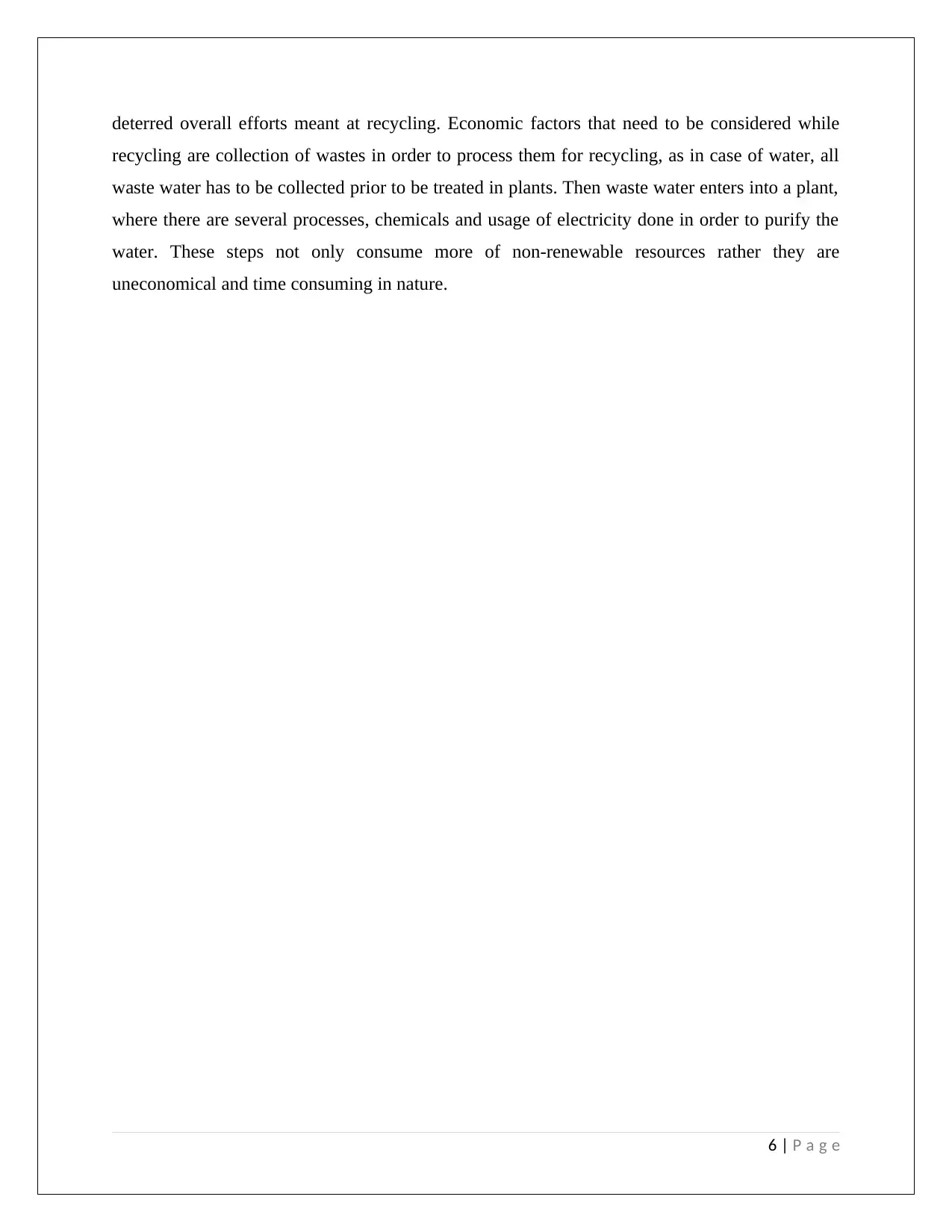
deterred overall efforts meant at recycling. Economic factors that need to be considered while
recycling are collection of wastes in order to process them for recycling, as in case of water, all
waste water has to be collected prior to be treated in plants. Then waste water enters into a plant,
where there are several processes, chemicals and usage of electricity done in order to purify the
water. These steps not only consume more of non-renewable resources rather they are
uneconomical and time consuming in nature.
6 | P a g e
recycling are collection of wastes in order to process them for recycling, as in case of water, all
waste water has to be collected prior to be treated in plants. Then waste water enters into a plant,
where there are several processes, chemicals and usage of electricity done in order to purify the
water. These steps not only consume more of non-renewable resources rather they are
uneconomical and time consuming in nature.
6 | P a g e
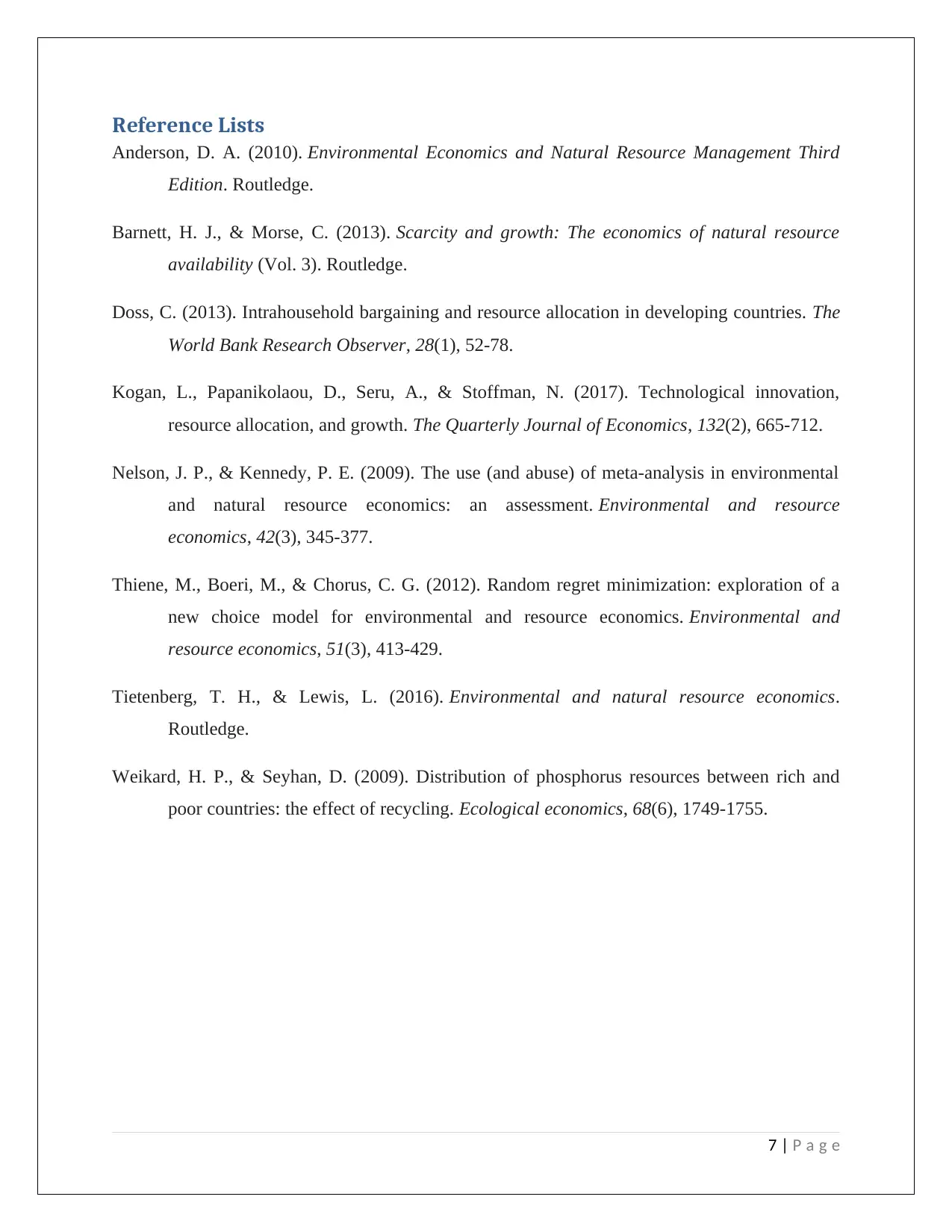
Reference Lists
Anderson, D. A. (2010). Environmental Economics and Natural Resource Management Third
Edition. Routledge.
Barnett, H. J., & Morse, C. (2013). Scarcity and growth: The economics of natural resource
availability (Vol. 3). Routledge.
Doss, C. (2013). Intrahousehold bargaining and resource allocation in developing countries. The
World Bank Research Observer, 28(1), 52-78.
Kogan, L., Papanikolaou, D., Seru, A., & Stoffman, N. (2017). Technological innovation,
resource allocation, and growth. The Quarterly Journal of Economics, 132(2), 665-712.
Nelson, J. P., & Kennedy, P. E. (2009). The use (and abuse) of meta-analysis in environmental
and natural resource economics: an assessment. Environmental and resource
economics, 42(3), 345-377.
Thiene, M., Boeri, M., & Chorus, C. G. (2012). Random regret minimization: exploration of a
new choice model for environmental and resource economics. Environmental and
resource economics, 51(3), 413-429.
Tietenberg, T. H., & Lewis, L. (2016). Environmental and natural resource economics.
Routledge.
Weikard, H. P., & Seyhan, D. (2009). Distribution of phosphorus resources between rich and
poor countries: the effect of recycling. Ecological economics, 68(6), 1749-1755.
7 | P a g e
Anderson, D. A. (2010). Environmental Economics and Natural Resource Management Third
Edition. Routledge.
Barnett, H. J., & Morse, C. (2013). Scarcity and growth: The economics of natural resource
availability (Vol. 3). Routledge.
Doss, C. (2013). Intrahousehold bargaining and resource allocation in developing countries. The
World Bank Research Observer, 28(1), 52-78.
Kogan, L., Papanikolaou, D., Seru, A., & Stoffman, N. (2017). Technological innovation,
resource allocation, and growth. The Quarterly Journal of Economics, 132(2), 665-712.
Nelson, J. P., & Kennedy, P. E. (2009). The use (and abuse) of meta-analysis in environmental
and natural resource economics: an assessment. Environmental and resource
economics, 42(3), 345-377.
Thiene, M., Boeri, M., & Chorus, C. G. (2012). Random regret minimization: exploration of a
new choice model for environmental and resource economics. Environmental and
resource economics, 51(3), 413-429.
Tietenberg, T. H., & Lewis, L. (2016). Environmental and natural resource economics.
Routledge.
Weikard, H. P., & Seyhan, D. (2009). Distribution of phosphorus resources between rich and
poor countries: the effect of recycling. Ecological economics, 68(6), 1749-1755.
7 | P a g e
1 out of 7
Related Documents
Your All-in-One AI-Powered Toolkit for Academic Success.
+13062052269
info@desklib.com
Available 24*7 on WhatsApp / Email
![[object Object]](/_next/static/media/star-bottom.7253800d.svg)
Unlock your academic potential
© 2024 | Zucol Services PVT LTD | All rights reserved.
